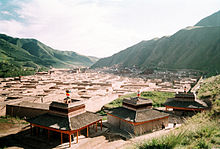
The Gelug is the newest of the four major schools of Tibetan Buddhism. It was founded by Je Tsongkhapa (1357–1419), a Tibetan philosopher, tantric yogi and lama and further expanded and developed by his disciples.
A tulku is a distinctive and significant aspect of Tibetan Buddhism, embodying the concept of enlightened beings taking corporeal forms to continue the lineage of specific teachings. The term "tulku" has its origins in the Tibetan word "sprul sku", which originally referred to an emperor or ruler taking human form on Earth, signifying a divine incarnation. Over time, this term evolved within Tibetan Buddhism to denote the corporeal existence of highly accomplished Buddhist masters whose purpose is to ensure the preservation and transmission of a particular lineage.

The Jonang is a school of Indo-Tibetan Buddhism. Its origins in Tibet can be traced to the early 12th century master Yumo Mikyo Dorje. It became widely known through the work of the popular 14th century figure Dolpopa Sherab Gyaltsen. The Jonang school’s main practice is the Kālacakra tantra, and they are widely known for their defense of the philosophy known as shentong.

Amdo is one of the three traditional Tibetan regions, the others being U-Tsang in the west and Kham in the east. Ngari in the north-west was incorporated into Ü-Tsang. Amdo is also the birthplace of the 14th Dalai Lama. Amdo encompasses a large area from the Machu to the Drichu (Yangtze). Amdo is mostly coterminous with China's present-day Qinghai province, but also includes small portions of Sichuan and Gansu provinces.

Thrangu Rinpoche was born in Kham, Tibet. He was deemed to be a prominent tulku in the Kagyu school of Tibetan Buddhism, the ninth reincarnation in his particular line. His full name and title was the Very Venerable Ninth Khenchen Thrangu Tulku, Karma Lodrö Lungrik Maway Senge. The academic title Khenchen denotes great scholarly accomplishment, and the term Rinpoche is a Tibetan devotional title which may be accorded to respected teachers and exemplars.

Nyingma, often referred to as Ngangyur, is the oldest of the four major schools of Tibetan Buddhism. The Nyingma school is founded on the first lineages and translations of Buddhist scriptures from Sanskrit into Tibetan in the eighth century, during the reign of King Trisong Detsen.

Tibetan Muslims, known in Tibet as the Khache, are Tibetans who adhere to Islam. Many are descendants of Kashmiris, Ladakhis, and Nepalis who arrived in Tibet in the 14th to 17th centuries. There are approximately 5,000 Tibetan Muslims living in China and over 1,500 living in India.

Xiahe County is a county in Gannan Tibetan Autonomous Prefecture, Gansu province, China, bordering Qinghai province to the west. The name, which literally means "Xia River", refers to the Daxia River which runs through the county. It is home to the famed Labrang Tibetan Buddhist monastery, one of the largest Tibetan Buddhist monasteries outside the Tibet Autonomous Region. The town is populated largely by ethnic Tibetans, as well as some Hui and Han Chinese. The area is highly rural and pastoral. The geography is mountainous. In recent years it has become a tourist attraction. The county was named Xiahe in 1928, after the Daxia River that flows through its territory.

Jamgön Kongtrül Lodrö Thayé, also known as Jamgön Kongtrül the Great, was a Tibetan Buddhist scholar, poet, artist, physician, tertön and polymath. He is credited as one of the founders of the Rimé movement (non-sectarian), compiling what is known as the "Five Great Treasuries". He achieved great renown as a scholar and writer, especially among the Nyingma and Kagyu lineages and composed over 90 volumes of Buddhist writing, including his magnum opus, The Treasury of Knowledge.

Ganden Monastery or Ganden Namgyeling or Monastery of Gahlden is one of the "great three" Gelug university monasteries of Tibet. It is in Dagzê County, Lhasa. The other two are Sera Monastery and Drepung Monastery. Ganden Monastery was founded in 1409 by Je Tsongkhapa Lozang-dragpa, founder of the Gelug order. The monastery was destroyed after 1959, but has since been partially rebuilt. Another monastery with the same name and tradition was established in Southern India in 1966 by Tibetan exiles.

Kyabje Dudjom Jigdral Yeshe Dorje was known as Terchen Drodül Lingpa and as Dudjom Rinpoche. He is considered by many Tibetan Buddhists to be from a line of important Tulku lineage, and a renowned Tertön. Per lineage, he was a direct incarnation of both Padmasambhava and Dudjom Lingpa (1835–1904). He was a Nyingma householder, yogi, and a Vajrayana and Dzogchen master. According to his disciple Khenpo Tsewang Dongyal, he was revered as "His Holiness" and as a "Master of Masters".
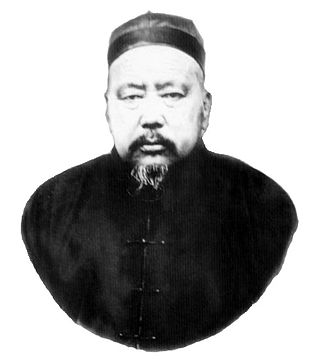
Ma Qi was a Chinese Muslim General in early 20th-century China.
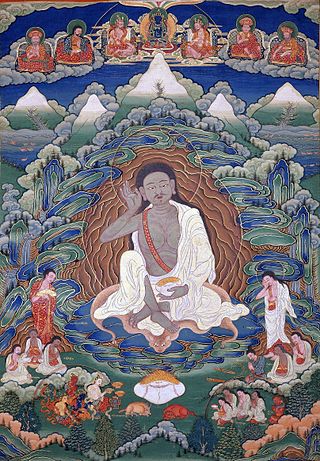
In Tibetan Buddhism and Bon, a ngagpa (male), or a ngagmo (female) is an ordained non-monastic practitioner of Dzogchen and Tantra. Traditionally, many Nyingma ngakpas wear uncut hair and white robes and these are sometimes called "the white-robed and uncut-hair group".
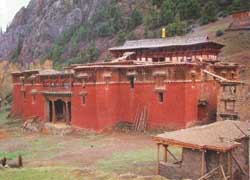
Karma Gon Monastery, the original monastery of the Karma Kagyu sect of Tibetan Buddhism, was founded in the 12th century by Düsum Khyenpa, the 1st Karmapa Lama in eastern Tibet at the age of 76. Karma Gon, is located on the eastern bank of the Dzachu River in Chamdo, eastern Tibet. Karma Dansa was the cradle of the karma kagyupas. When established the Karmapa had gathered 1000 monks around him here. Karma Gon was named as Karma Dansa as an administrative unit and the Chinese Ming Court enlarged the monastery’s jurisdiction by adding the Mekong’s middle and upper reaches. It was then also called Gama Dansa Si in Chinese.

Kathok Monastery, also transliterated as Kathog, Katok, or Katog, was founded in 1159 and is one of the "Six Mother Monasteries" in Tibet of the Nyingma school of Tibetan Buddhism, built after Samye Monastery. It is located in Payul, Garzê Prefecture, Sichuan, China, in the region traditionally known to Tibetans as Kham.
The Jamyang Zhepas are a lineage of tulkus of the Gelug school of Tibetan Buddhism. They have traditionally been the most prestigious teachers at Labrang Monastery in Amdo, Tibet.
The Muslim Conflict in Gansu broke out when a coalition of Muslim generals revolted against the Guominjun in 1927. Prominent among the rebels was Ma Tingxiang, the son of the General Ma Anliang, who received aid in the form of arms from Zhang Zuolin in Manchuria.
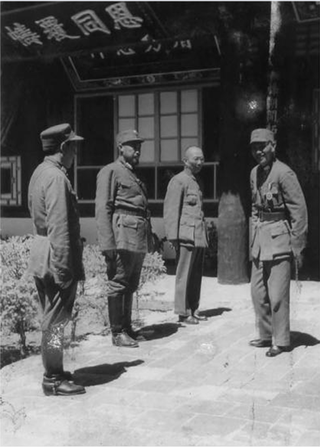
The Ma clique fought a series of military campaigns between 1917 and 1949 against unconquered Amchok and Ngolok (Golok) tribal Tibetan areas of Qinghai (Amdo), undertaken by two Hui commanders, Gen. Ma Qi and Gen. Ma Bufang, on behalf of the Beiyang and Kuomintang governments of the Republic of China. The campaigns lasted between 1917 and 1949. The conflict was spurred by multiple factors, notably for economic and socio-political reasons rather than by any racial or religious enmity.

Nyoshül Khenpo Rinpoche, more fully Nyoshül Khenpo Jamyang Dorje, was a Tibetan lama born in the Derge region of Kham.
The Ninghai Army, later the 26th Division (National Revolutionary Army) was a Muslim Hui army of the Republic of China commanded by General Ma Qi, who controlled the Xining area of Qinghai, then a special region of Gansu province. It was founded by Ma Qi in 1915.
